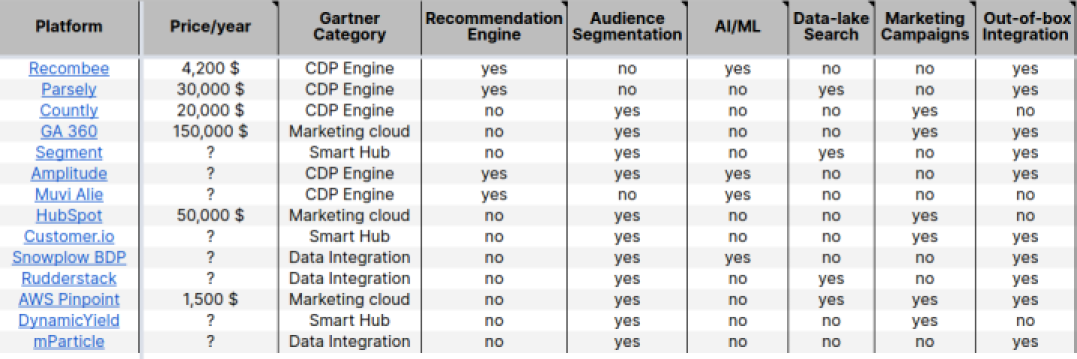- Conversion Rate Optimization with Personalization
- Personalizing Pages on WordPress
- Personalization on the Web

In our previous post, we explored how personalization of a page can be achieved within a WordPress environment. First-party data can be used to display conditional content blocks in a page editor such as Gutenberg. However, to persist personalized content over multiple interactions, a persona based on segmentation is a more robust approach.
Segmentation is best achieved with the help of a data analysis tool that will expose common user journeys to desired goals. For a business website that seeks to optimize its conversion rate, a segmentation reporting tool can be a powerful tool in their arsenal, but requires good tracking data of its visitors to fine-tune the analysis.
This post compares various Customer Data Platforms and their integrations to personalize WordPress pages as a tool for conversion rate optimization.
Segmentation vs Recommendations
A Customer Data Platform (CDP) collects user behaviour on a website, tracks their preferences, the pages they liked & shared, products they purchased, forms they submitted, and more, enabling an analysis of users’ complete journey over multiple visits to the site.
CDPs therefore have the ability to recommend content/articles/products to a user based on their historical interaction on the website. For example, a recommendation can be displayed as a widget list or some links/buttons at the bottom of a page. CDP recommendation algorithms will select the best content related to the history of the user, as well as exclusive to that history. This ensures that recommended content has never been consumed by the user.
A recommendation engine is good to maximise content consumption on a site, a strategy favoured by publishing or ecommerce businesses to increase user retention. However, for businesses that leverage their website for lead-generation a different approach to personalization is required, one that optimizes user journeys that lead to conversions. This is where segmentation of users into profiles or personas becomes relevant.
Customer Data Platforms for Optimal Segmentation
A number of CDPs integrate a visitor’s data tracking with a suite of analytical tools to identify common journeys taken by successful conversions.
An understanding of users’ journeys that lead to conversions can be used to segment these users into profiles or personas that can then be used to show personalized and more relevant content to visitors and increase conversions under the assumption that users with common profiles and behaviours are likely to follow similar journeys.
Multi-brand / Multi-site User Journey Segmentation
CDP based segmentation is evermore relevant in the context of tracking users over multiple sites, which allows marketers to get a better picture of their conversion journeys. Cross-brand/site segmentation can permit more relevant interlinking of information between different sites, and therefore enhance a user’s experience.
A B2B Business Example for Restaurateurs
Imagine a business that caters to restaurateurs, selling custom kitchen equipment from grills to deep-freezers. For branding/marketing needs, many of these equipments are hosted on different sites. Such a business would seek to convert visitors to sign up for an in-person discussion on their specific requirements in order to provide them with a quote.
A user searching for grilling equipment to launch their new Mongolian BBQ restaurant would likely land on the business site’s grills page and start exploring their products/services associated with such kind of equipment. The user would typically compare several brands before deciding, meaning they would make several visits to the site, identifying them with a certain profile/audience. Furthermore, the user may also be identified on a related brand site, looking at fridges, for example.
A CDP integrating these various sites and tracking this user’s journey across different products would enable a more refined segmentation such that subsequent visits to the home and other landing pages personalize the content in such a way to further entice the user to sign-up for a quote with, for example, a discount offer on the purchase of a grill and a fridge from different brands.
This uniform experience for the user is made possible with the CDP’s seamless cross-site tracking. The business also benefits from a more detailed view of the different restaurant businesses knocking at their door from the analysis and reporting tools built into the CDP.
Comparing CDP Services
A CDP is first and foremost a multichannel data aggregation service that focuses on first-party data in order to uniquely identify users on a website. Personally Identifiable Information (PII) collected from multiple sources (websites, apps, CRMs, marketing campaigns and so on) are reconciled in order to have a unified dataset for a given user and reduce profile duplication.
CDP services are generally cloud-based SaaS services and can vary in the functionality they offer. Below is a table that compares a number of CDP services currently available on the market. It is by no means an exhaustive list. However, as per Gartner’s Market Guide for Customer Data Platforms a CDP should enable the following,
- Data collection of first-party data in real time from multiple sources with no restriction on storage limit.
- Profile unification of users interactions across multiple touch-points, the ability to identify users using various attributes and therefore eliminating duplicate data. Some CDPs offer the ability to unify multiple users and assign them to a household or a company, in the case of B2B business sites.
- Segmentation of users using basic rules or in combination with analysis of user behaviour. Some CDPs may offer advanced features that allow for automated profiling with AI/ML algorithms or importing such models from other data analysis services.
- Activation of CDP’s information for dynamic personalized content on a web page or for marketing campaigns. However, many CDPs offer an API for retrieval of this information and the activation is implemented using a 3rd party plugin or service, enabling greater flexibility in the implementation.
In addition to these, a number of CDPs offer additional functionality to marketers and website managers.
Categories of CDPs
To differentiate the different type of CDPs, the Gartner report identifies and groups CDP according to the functionality they provide as follows,
- CDP Engines with toolkits are services that offer data pipeline solutions but are limited in the ability to analyse the data and build segmentation profiles, requiring additional custom integration or implementation of functionality.
- Data Integration or Composable CDPs offer bridges to existing services for data storage and analysis. They enable linking of various services to create a data pipeline. The advantage is that users have better control of their own data, but the integration of different 3rd-party services can be a more expensive solution.
- Marketing cloud CDPs offer additional marketing functionality such as email marketing campaigns targeting segmented users.
- Smart Hubs are CDP services that in addition to marketing functionality enable the creation of personalized content on landing pages based on segmentation analysis, run A/B testing campaigns or track marketing campaigns with UTM parameters.
CDP Comparison Table
Here is a comparative Google sheet table of a number of CDPs reviewed for this article, and by no means an exhaustive list. The pricing for each is still a work-in-progress, and we will continue to update the table as and when we have more data.

Conclusion
A Customer Data Platform is a powerful tool to integrate into an ecosystem of multi-brand business over multiple websites, enabling a better tracking of customer journeys and interactions. The CDPs segmentation functionality can then be leveraged to personalize website landing pages in order to improve the user experience and optimize lead conversions.
In the next post, we explore a concrete example that integrates a WordPress website with Salesforce Marketing Cloud user segmentation functionality, enabling marketers to create email campaigns that connect to personalized landing pages on the WordPress site.
Let’s start a conversation
Are you looking to integrate a CDP in your online business ecosystem? We can help you build it out, end-to-end.
Leave a Reply